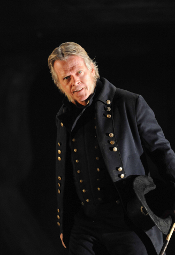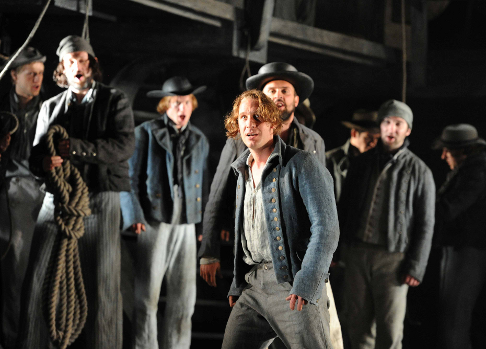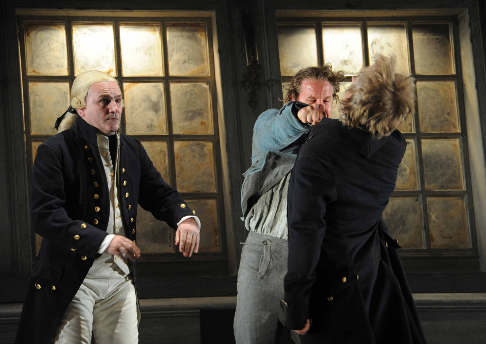22 May 2010
Imbrailo stars as Billy Budd in Glyndebourne
Star born through stutter? It’s immediately obvious that Jacques Imbrailo’s Billy Budd at Glyndebourne is an extraordinary portrayal. His stammer is more expressive than speech.

Star born through stutter? It’s immediately obvious that Jacques Imbrailo’s Billy Budd at Glyndebourne is an extraordinary portrayal. His stammer is more expressive than speech.
The cannons don’t get to shoot the Frenchies, Vere cannot resolve his conflicts, but inarticulate Billy overcomes huge obstacles and gets things done. He pays the price for inadvertently killing Claggart, but no-one intervenes. Captain Vere’s paralyzed by conscience, trapped in the fogs of scruple. Billy, though, is instinctive, physical, direct. Imbrailo lives the part in his body. No makeup can turn his face red so quickly, no costume can create the tense, twisted coil of his frame.
Imbrailo’s Billy is musically astute, as stammer is integral to Britten’s music. The mutiny, in Billy Budd, is in the music. So echoes of Billy’s stammer burst out in recurrent staccato in the orchestra, disruptive protests against the rigidity of naval life. The sailors don’t mutiny, but Billy’s stammer comes to affect the rhythms in other voices, even Claggart’s. Like Billy, Britten expresses himself in abstract sound, rather than relying on words alone. Orchestration as protagonist. In Billy Budd, Britten shows why he didn’t need to write symphonies.
 Phillip Ens as Claggart
Phillip Ens as Claggart
Significantly, in this new production directed by Michael Grandage, what
stands out most in Billy’s star aria, “Through the port comes moonshine astray” isn’t the usual lyrical magic but the phrase “I’m strong, and I know it, and
I’ll stay strong!” Imbrailo’s “Beauty” isn’t a passive “Baby” but an assertive
force of life.
Yet central to the whole opera is Captain Vere’s dilemma. He’s spent a lifetime trying to understand what Billy meant. What is “the love that passes understanding”? In this production, Vere recedes almost into the background. No “Starry Vere” here, fixed on a more rarefied intellectual plane, thinking of Scylla and Charybdis.Vere is tormented because he is a man who thinks.
Instead, this Vere is one of the boys. He doesn’t even wear a hat when he’s with the other officers. In the scene where Billy is hanged, he’s seen as an old man in a dressing gown, as still as a statue among the teeming crowd of sailors. Grandage is making a valid point, but this neuters Vere’s position. In this scene, Vere is still Captain, still capable of action, hamstrung as he is by his quandary. John Mark Ainsley sings beautifully, as he always does, but this production doesn’t make full use of his potential.
If Vere’s pivotal role is underplayed, Claggart, in this production, is developed unusually well. Philip Ens makes Claggart twitch with sexual tension. Like the mists that trap the ship, and the haze that shrouds the stage, this Claggart oozes poison so pervasive that just hearing Ens makes one feel unclean — he’s a great actor, and his voice twists and elides in a sinister way. How did this Claggart come to be who he is? This portrait of warped sexuality is almost too awful to contemplate.
This is an extremely dark production, in all ways. Definitely not a cheery sailor story! Christopher Oram’s set is claustrophobic. We’re inside the bowels of the ship, not on deck, and certainly not in the foretop, where Billy feels free. You can almost smell the fetid air, and feel the cramped, damp chaos. Psychologically, this is astute, but becomes oppressive in itself.
 Jacques Imbrailo as Billy Budd (foreground centre).
Jacques Imbrailo as Billy Budd (foreground centre).
The transfer scene, where Billy sings “Farewell to the Rights of Man” might have sounded more poignant if we’d “seen” the bright hope of the other ship in some way. Later, soldiers in brilliant red and white uniforms appear. They’re a delight to the eyes, but distract from the grimness of what’s happening. The real brightness in this opera is Billy, and his transfiguration. The set is also not flexible, despite intelligent use of lighting (Paule Constable), and works less well after the First Act. Also, the protracted tying of the noose within sight of the condemned man seemed excessive. The music at this point is so amazing, that we should be listening, not watching.
This was Mark Elder’s first Billy Budd. He conducted the London Philharmonic Orchestra so the strong undercurrents of Britten’s music flowed well. In a production as dark as this, though, more sharpness of attack would have captured the edginess in the music, but Elder understood the recurrent “stammers” well. Dulled, pounding thrusts, as instinctive and direct as Billy’s stutter.
 John Mark Ainsley as Captain Vere, Jacques Imbrailo as Billy Budd and Phillip Ens as Claggart
John Mark Ainsley as Captain Vere, Jacques Imbrailo as Billy Budd and Phillip Ens as Claggart
“Rum, sodomy and the lash” don’t really fit in with Glyndebourne’s elegant, summertime ambiance, so it is no surprise that it’s taken 60 years to become part of the Festival. But it’s a measure of Glyndebourne’s artistic integrity that this particularly brutal production is done at all. This Billy Budd will be revived many times. The theatre at Glyndebourne is small, but the Festival reaches out all over the world, to a much bigger audience through broadcasts and DVD releases. Relatively few may attend in person, but the potential is huge, for Glyndebourne’s artistic standards are extremely high.
Hopefully, if they film this Billy Budd, they’ll do it with Jacques Imbrailo, who is so good that his star is very definitely in the ascendant.
Anne Ozorio